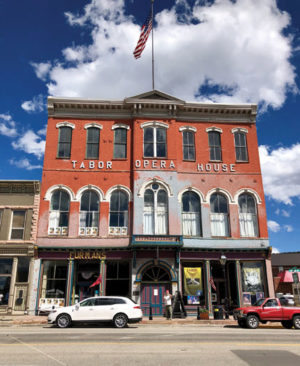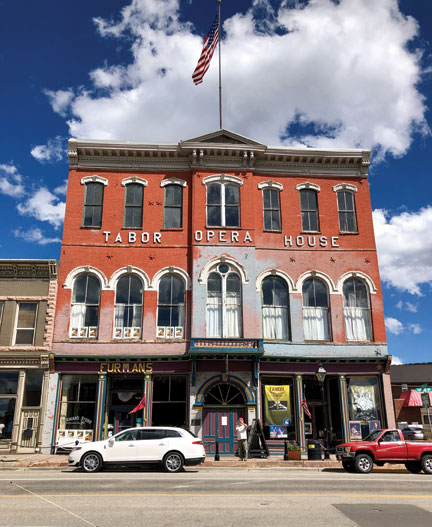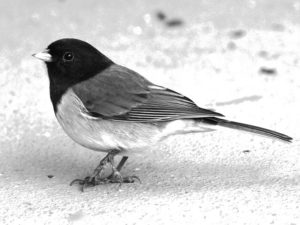Article and photo by Kim Grant, Colorado Preservation, Inc.
The long-sought rehabilitation of Leadville’s venerable Tabor Opera House is poised to move forward following significant success in fundraising efforts that will enable initial work on the west (front) and south facades next Spring (2020). The property is viewed as a catalyst for the revitalization of Leadville’s downtown, a National Historic Landmark District, but was placed on Colorado’s Most Endangered Places List in 2016 due to the uncertainty about its future at the time and its deteriorating condition.

The Tabor Opera House was built in 1879 and financed by one of Colorado’s best-known mining entrepreneurs, Horace Austin Warner Tabor. The Tabor Opera House opened on November 20, 1879, a mere 100 days after its initial construction began. The three-story building included two retail stores on the first floor, an elegant theater on the second floor, and a third floor that connected to the adjacent Clarendon Hotel via an above ground passageway. The ornate interior boasted 72 gas jets (the first gas lights to illuminate Leadville), richly painted walls and ceiling frescoes, custom carpets, and hand-painted stage curtains. Oscar Wilde, Harry Houdini, John Philip Sousa, and Buffalo Bill were among the famous entertainers and speakers who performed at the Tabor Opera House.
Horace Tabor lost his fortune following the 1893 Silver Crash and the property changed hands. In 1901 the Order of the Elks acquired the building and carried out extensive remodeling for use as a lodge, theater and meeting hall. Fortunately, much of the original stage scenery, props and basement dressing rooms used by stage celebrities of the 1880s were retained. After the Elks built a new lodge in 1954, the future of the Tabor Opera House stood in jeopardy. The property survives today thanks to those who recognized the significance of the building and remained dedicated to retaining this iconic monument of Colorado history. Evelyn Livingston Furman purchased the building to save it from demolition in 1955. The Tabor functioned as a seasonal entertainment venue under the ownership of the Furman family which has continued through three generations until recently, when the city of Leadville purchased it for $600,000.
[InContentAdTwo]
In 2018, a comprehensive feasibility study was completed by Progressive Urban Management Associates (PUMA) to analyze the feasibility and funding sources required for various re-use scenarios for the building. Since that time a capital campaign to raise $10 million over 10 years has emerged that has quickly generated $1 million in support from several sources, including a Save America’s Treasures grant, with matching funds provided by American Express, The National Trust for Historic Preservation, the Leadville Main Street Program and dozens of local donors. Initial Phase I rehabilitation work will take place early next year under the direction of Hoehn Architects, P.C. and will be funded in part by a grant from the State Historical Fund. While much fundraising remains to enable full rehabilitation, the Tabor Opera House is well on its way to a bright future as the centerpiece of a new era in Leadville’s long and colorful history. For information, contact Colorado Preservation, Inc. at 303-893-4260 x222 or email Tabor Opera House Foundation board president Mary Ann Graham-Best at president@taboroperahouse.nt


